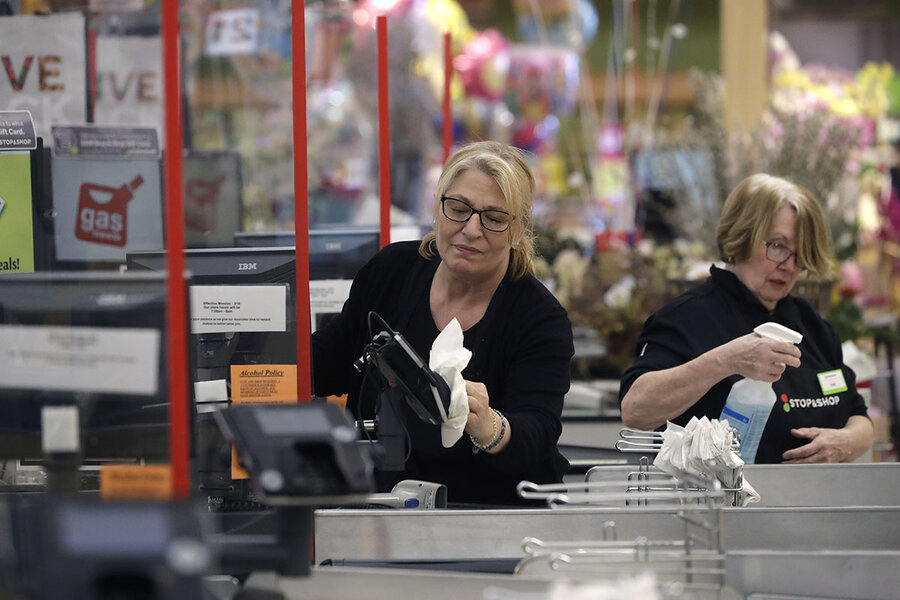Going cashless? Not everyone has an app for that.
Loading...
| Cincinnati
When the pandemic hit, Cincinnati restaurateur Jean-François Flechet saw the opportunity he had been looking for: Finally, it was a good time to ditch cash payments, as well as the time spent counting change and running to the bank that went along with it. Starting in May 2020, most of his stores went card-only.
“That was 100% because of the pandemic. At the time everybody was sanitizing everything. Cash is dirty to start with,” says Mr. Flechet, owner of a handful of Belgian eateries. The pandemic-induced cash shortage only made the switch more obvious. “I wanted to do cashless for a long time, so the pandemic provided one more argument at the time to really flip the switch.”
Mr. Flechet isn’t alone. While statistics on businesses in the U.S. that have completely dropped cash are scarce, payment-processing company Square reported that the percentage of payments its clients processed in cash dropped just over 8 points in 2020, to about 30%, an acceleration of a downward trend the company has been recording since 2015. And as businesses of all stripes embraced varying strategies – from contactless payments, to online orders, to home delivery – to avoid human contact during the health crisis, some companies responded by dropping cash acceptance altogether.
Why We Wrote This
A shift away from cash accelerated during the pandemic, and the efficiency of electronic payments is hard to doubt. But the trend can pose challenges for millions of Americans who don’t have bank accounts.
As cards and payment apps become ubiquitous, 95% of Americans probably wouldn’t bat an eye at Mr. Flechet’s cashless establishment. But in our increasingly digital world, there’s an often invisible 5% of Americans who don’t have checking accounts, according to Federal Reserve data. That means a significant number of Americans face one more disadvantage in their financial lives, which is overwhelmingly a struggle for this group to begin with.
“Cashless restaurants, cashless services – what initially came to mind for me was, ‘That wasn’t created with me in mind,’” says Wendell Williams. Mr. Williams, now a Washington, D.C., social worker, has faced bouts of homelessness, during which time he didn’t always have access to a bank account. Bank accounts come with fees and ID requirements that can be onerous for low-income people and immigrants. “The average person experiencing homelessness, or [who is] poor, is probably not likely to have that kind of stuff at his disposal.”
The accelerated pandemic shift away from cash follows a wave of businesses that have dropped the payment method in recent years or never accepted it in the first place. But opposition to electronic-only payment has been around for decades, long before Square, Apple Pay, or COVID-19 were household names. The concerns now are the same as they were in the 1970s, when Massachusetts banned businesses from not accepting cash: It discriminates against people without – or with limited – access to bank accounts, notably poor people, immigrants (authorized or not), and people who are homeless. In addition to people without accounts at all, another 16% of Americans are “underbanked,” the Federal Reserve estimates. This group has checking accounts, but still uses services like payday loans or check-cashing services – often due to low incomes, a lack of banks in their neighborhood, or poor transportation.
Amid reluctance by some stores to handle cash during the pandemic, Massachusetts Attorney General Maura Healey doubled down, tweeting, “I understand that essential businesses need to take extra precautions right now. But not everyone has a credit card, and consumers should not face economic barriers to accessing necessary goods and services.”
Massachusetts isn’t alone in having banned stores from going cashless. Similar measures were passed in recent years in New Jersey and Rhode Island on the state level, and Philadelphia and San Francisco on the city level.
“Removing the option for cash is bad for low-income people, for the undocumented, for privacy, and it in general reduces consumer choice and control over their lives,” says Jay Stanley, a senior policy analyst with the American Civil Liberties Union. He’s quick to point out credit card data is tracked and sold to advertisers, raising concerns for the privacy-minded. “To get a credit card or other cashless payment system requires getting enmeshed in bureaucratic banking systems, showing ID, proving residency – things that a lot of people have trouble doing. It often involves a lot of fees that poor people who are living an economically difficult existence don’t want or are not able to pay.”
Left behind
These issues were on Mr. Flechet’s mind when he made his transition to cashless restaurants. But the problems of people being unbanked are not evenly distributed: Only a small percentage of Mr. Flechet’s customers used cash, making tracking it, counting it, making change, and depositing the day’s earnings in the bank a hassle. But a small percentage for Mr. Flechet translates to bigger numbers nationwide. In the Bronx, a borough of New York City, for example, nearly 1 in 5 households were recorded as unbanked in 2017. Federal Deposit Insurance Corp. data from 2019 showed that Jackson, Mississippi, held a similar rate, at 17%, and in the Houston metro area it was 1 in 10 – but in the Seattle metro area, it was below the national average, at 2.6%. The biggest challenge cited to having an account by those surveyed was not being able to meet minimum balance requirements, followed by trust issues, privacy concerns, problems related to fees and credit, and bank locations and hours.
Advocates say an important solution comes from nonprofits and credit unions specializing in first-time account holders, willing to take on nontraditional clients. In June, financial technology startup MAJORITY announced it had raised $19 million in funding for its mobile banking system targeted at immigrants and others who struggle with banking bureaucracy.
Mr. Williams felt that way – even though he was born in the U.S.
“Fear is the major enemy of any kind of change. And you work under the assumption that you’ve had so many noes, and doors closed in your face, that you say, ‘They won’t possibly give me a bank account,’” he says. He got his first account through a teachers credit union that was willing to take him on, after a friend recommended it to him. Without that direct outreach, he doesn’t think it would have happened. Now, as a social worker, part of his job involves tracking down people without housing or without bank accounts in order to get them money they deserve, such as their federal stimulus checks, many of which are still outstanding and unclaimed.
Mixed results
Around the world, cashless systems are playing out in different ways, and with different results. In Sweden and Norway, where the use of cash has dwindled in recent years, financial authorities have actually spoken out about their economies leaning too far into cashless payments. In Africa, mobile money transfers – which fall somewhere between a bank account, a money order, and Venmo – have exploded in recent years. Some researchers have credited the systems with lifting people out of poverty, though others have disputed the findings, and worry about predatory fees and rates.
Mr. Flechet decided to allow one of his locations to continue accepting cash, a stand located in Cincinnati’s historic Findlay Market. Though the surrounding neighborhood has gone through a wave of gentrification, Mr. Flechet was concerned about unbanked people in the area being locked out of his business.
“It would be too difficult to be cashless” in that location, he says, stressing that his decision to go cashless in other locations wasn’t based on any aversions to unhoused or poor people, but rather a business decision. In Findlay Market, which has a long history of cash-only spots, turning down cash doesn’t make sense: “Sometimes traditions and habits are hard to change.”
It wasn’t far from Findlay Market where Mr. Williams, while unhoused and living in Cincinnati, was able to get a bank account with a local credit union. While he was a vendor for the local street paper – produced and sold by poor and unhoused people in the community – the Communication Workers of America credit union let newspaper workers get paid through in-house accounts. With documented pay, he was able to get his first apartment.
It was a simple solution, he says, but a powerful one – more powerful than just banning a business from ditching cash. “See,” he asks, “how it can play into getting a better life for people, access to banking?”






